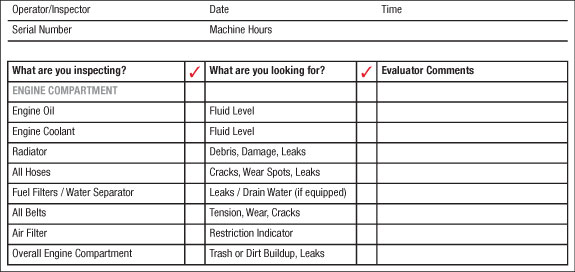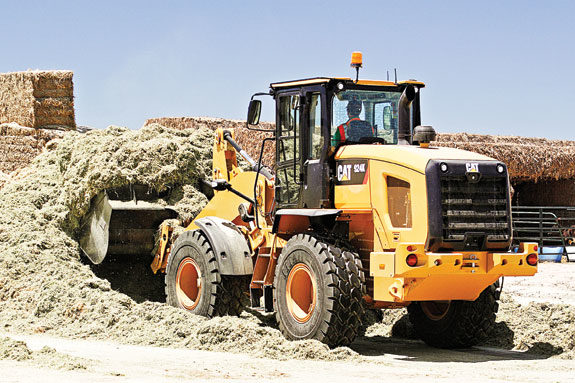Operating a loader, or any other type of machine, can be a dangerous activity if certain guidelines are not followed. A good understanding of working environments and machine capabilities is critical to safe operation. The following are guidelines to follow before, during and after operating a loader (not all-inclusive; always refer to your operation and maintenance manual for complete instructions).
See an example (below right) of a safety and maintenance checklist for the engine compartment portion of wheel loaders.
Before operating the loaderObtain a pre-shift checklist if available and complete it accurately. It is important to always record the results of inspections. Additionally:
 • Review your operation and maintenance manual before operating; know the safety precautions.
• Review your operation and maintenance manual before operating; know the safety precautions.
• Inspect the condition of the tires or track shoes for excessive wear, cracks and bulges.
• Verify all fluids are at the right levels.
• Inspect the condition of the bucket, nuts, bolts and other wear items for cracks or damage.
• Verify there are no rocks, debris or other material that could fall back into the cab.
• Always wear the proper personal protective equipment (PPE) for the job. Some applicable forms of PPE include leather gloves, protective helmets, eye and ear protection and steel-toed boots (make sure work boots have good tread).
• Use caution accessing and exiting the cab of the machine; maintain three points of contact at all times.
• Verify all gauges are working properly and the inside of the cab is ready for safe use.
Operating the loader
• Always wear seat belt and honk horn before moving the loader.
• In cold conditions, start the engine and let it run at idle speed for 15 minutes before operating; exercise the bucket up and down a few times to warm the hydraulic oil.
• Never exceed speed limits and do not make sharp turns or aggressive moves. Never operate on an incline with the load in the raised position, as this could result in the tipping of the load or loader.
• Do not exceed the rated loads for the equipment; always attempt to center the load to the bucket when loading and unloading.
• Always be aware of surroundings. Use a spotter and know where pedestrians, objects, overhangs, fall hazards, uneven conditions and other vehicles are at all times.
After operating the loader
• Let the loader run at idle speed for five minutes before completely shutting down.
• Lower the bucket to the ground to avoid stress on hydraulic systems.
• Clean the loader off with high-pressure water before any mud or debris hardens.
• Inspect and verify the same items from before you operated the loader (see above)
• Shut off the engine before refueling. PD
—Excerpts from Caterpillar, Inc. Toolbox Talks , which are intended to facilitate health and safety discussions on job sites. For additional information visit safety.cat.com
PHOTO:
TOP RIGHT: A good understanding of working environments and machine capabilities is critical to safe operation. Photo courtesy of Caterpillar, Inc.






